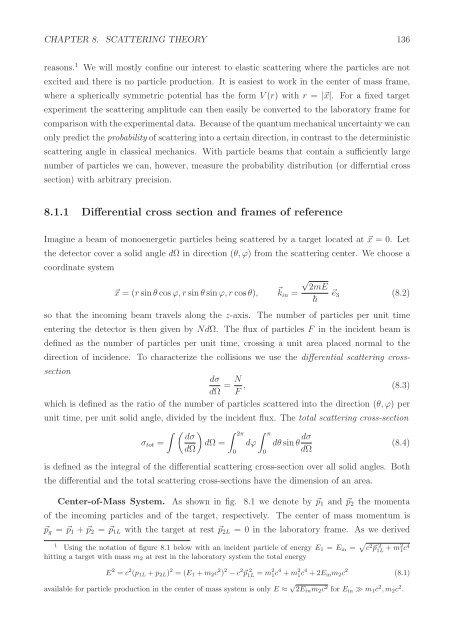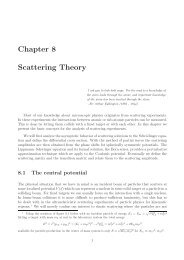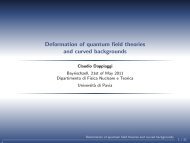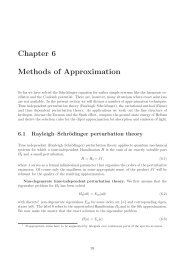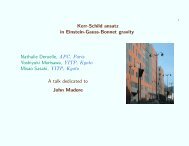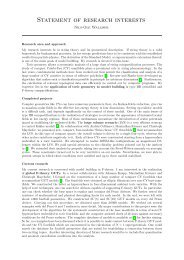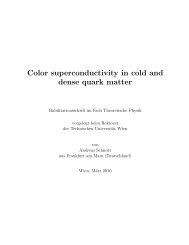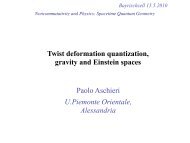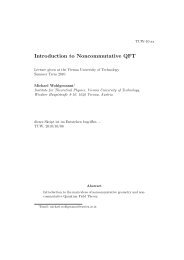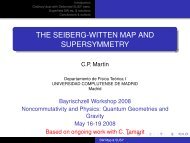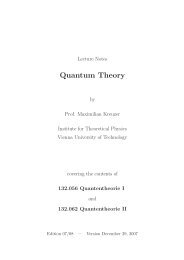Chapter 8 Scattering Theory - Particle Physics Group
Chapter 8 Scattering Theory - Particle Physics Group
Chapter 8 Scattering Theory - Particle Physics Group
Create successful ePaper yourself
Turn your PDF publications into a flip-book with our unique Google optimized e-Paper software.
CHAPTER 8. SCATTERING THEORY 136<br />
reasons. 1 We will mostly confine our interest to elastic scattering where the particles are not<br />
excited and there is no particle production. It is easiest to work in the center of mass frame,<br />
where a spherically symmetric potential has the form V (r) with r = |⃗x|. For a fixed target<br />
experiment the scattering amplitude can then easily be converted to the laboratory frame for<br />
comparison with the experimental data. Because of the quantum mechanical uncertainty we can<br />
only predict the probability of scattering into a certain direction, in contrast to the deterministic<br />
scattering angle in classical mechanics. With particle beams that contain a sufficiently large<br />
number of particles we can, however, measure the probability distribution (or differntial cross<br />
section) with arbitrary precision.<br />
8.1.1 Differential cross section and frames of reference<br />
Imagine a beam of monoenergetic particles being scattered by a target located at ⃗x = 0. Let<br />
the detector cover a solid angle dΩ in direction (θ,ϕ) from the scattering center. We choose a<br />
coordinate system<br />
⃗x = (r sin θ cos ϕ,r sin θ sin ϕ,r cosθ), ⃗ kin =<br />
√<br />
2mE<br />
<br />
⃗e 3 (8.2)<br />
so that the incoming beam travels along the z-axis. The number of particles per unit time<br />
entering the detector is then given by NdΩ. The flux of particles F in the incident beam is<br />
defined as the number of particles per unit time, crossing a unit area placed normal to the<br />
direction of incidence. To characterize the collisions we use the differential scattering crosssection<br />
dσ<br />
dΩ = N F , (8.3)<br />
which is defined as the ratio of the number of particles scattered into the direction (θ,ϕ) per<br />
unit time, per unit solid angle, divided by the incident flux. The total scattering cross-section<br />
∫ ( ) ∫ dσ 2π ∫ π<br />
σ tot = dΩ = dϕ dθ sin θ dσ<br />
(8.4)<br />
dΩ<br />
dΩ<br />
is defined as the integral of the differential scattering cross-section over all solid angles. Both<br />
the differential and the total scattering cross-sections have the dimension of an area.<br />
0<br />
Center-of-Mass System. As shown in fig. 8.1 we denote by ⃗p 1 and ⃗p 2 the momenta<br />
of the incoming particles and of the target, respectively. The center of mass momentum is<br />
⃗p g = ⃗p 1 + ⃗p 2 = ⃗p 1L with the target at rest ⃗p 2L = 0 in the laboratory frame. As we derived<br />
1<br />
Using the notation of figure 8.1 below with an incident particle of energy E 1 = E in = √ c 2 ⃗p 2<br />
1L + m2 1 c4<br />
hitting a target with mass m 2 at rest in the laboratory system the total energy<br />
E 2 = c 2 (p 1L + p 2L ) 2 = (E 1 + m 2 c 2 ) 2 − c 2 ⃗p 2<br />
1L = m 2 1c 4 + m 2 1c 4 + 2E in m 2 c 2 (8.1)<br />
available for particle production in the center of mass system is only E ≈ √ 2E in m 2 c 2 for E in ≫ m 1 c 2 ,m 2 c 2 .<br />
0


